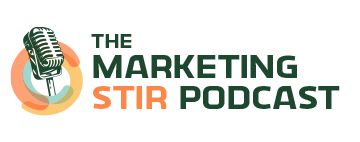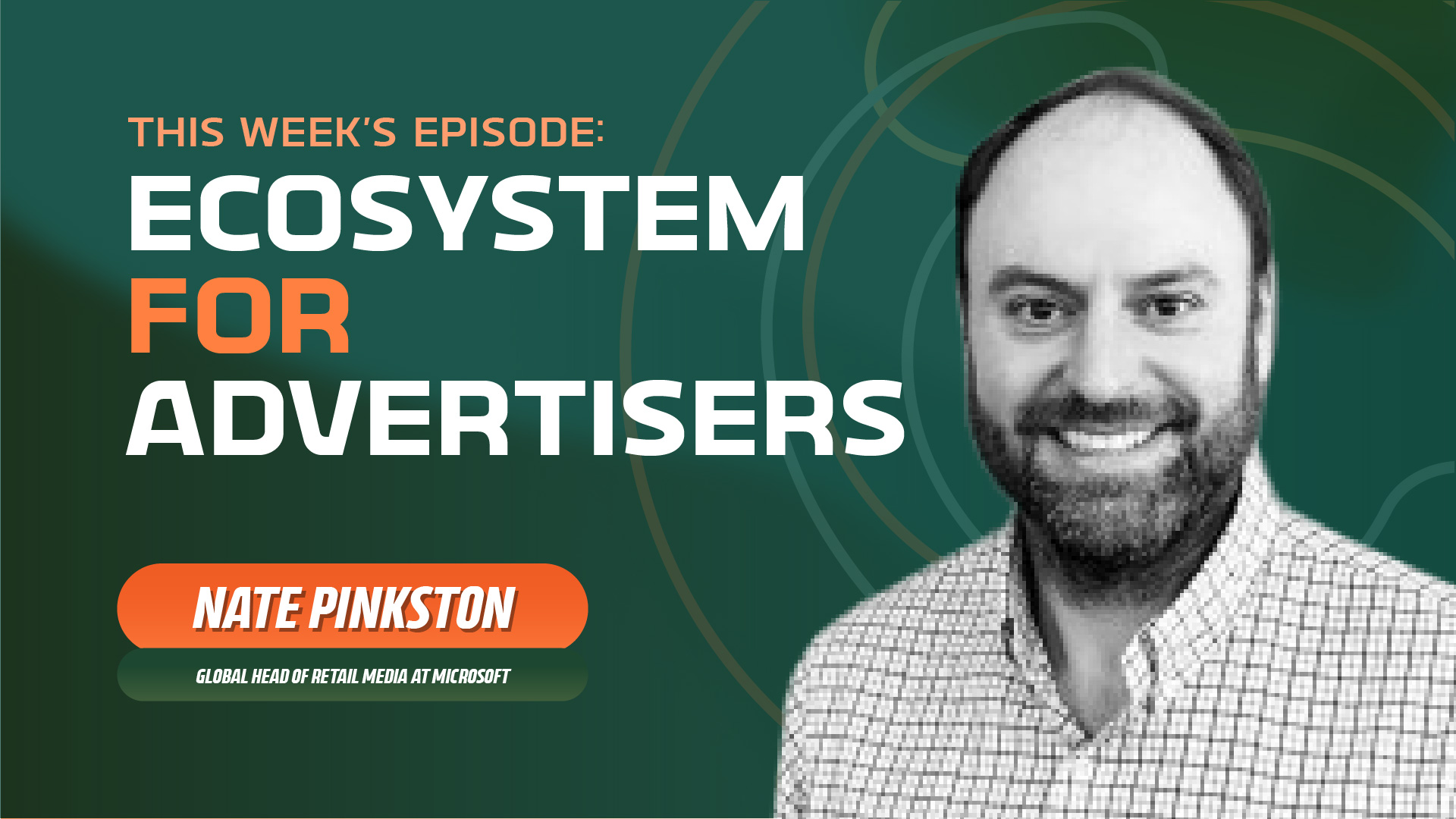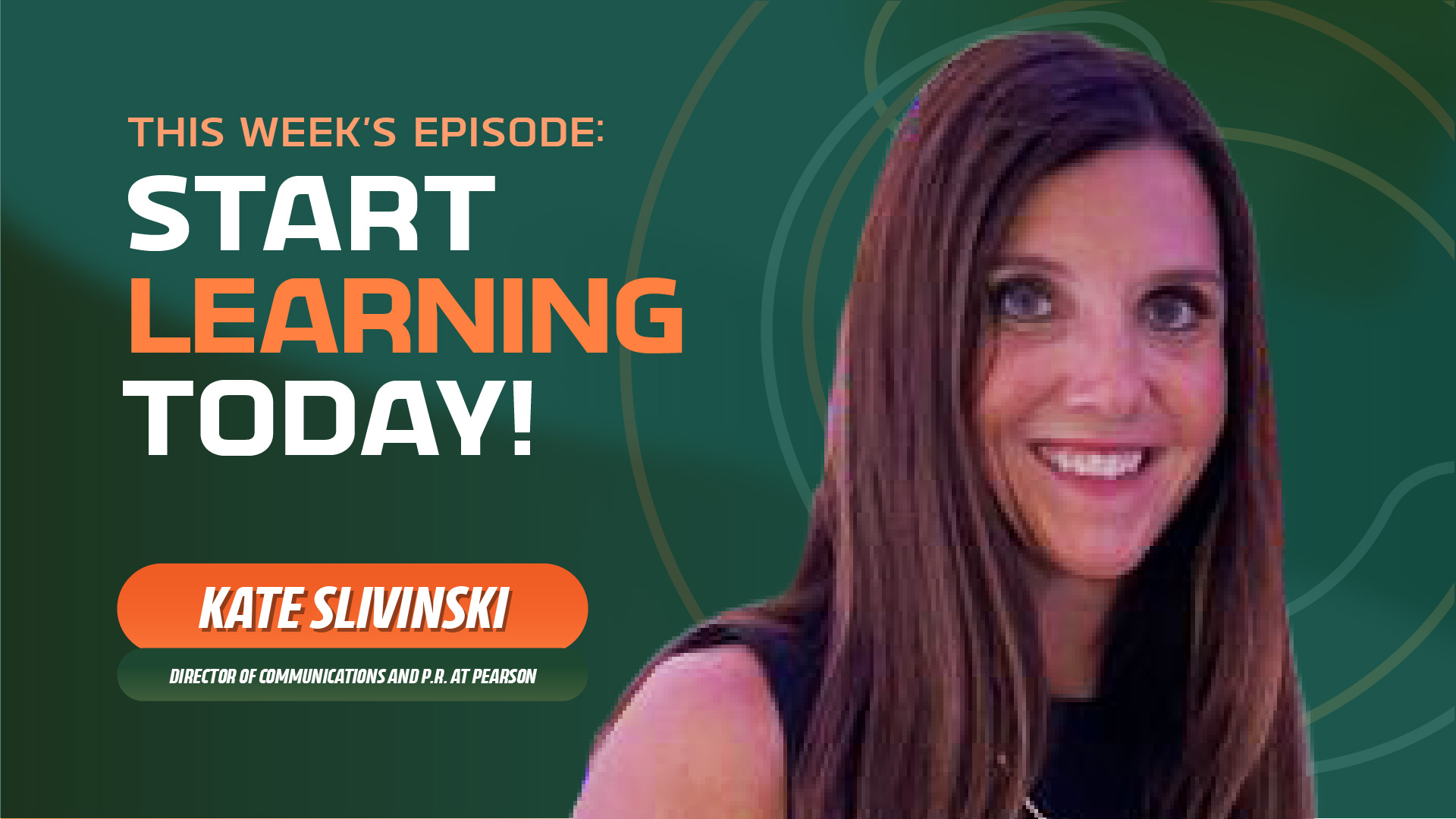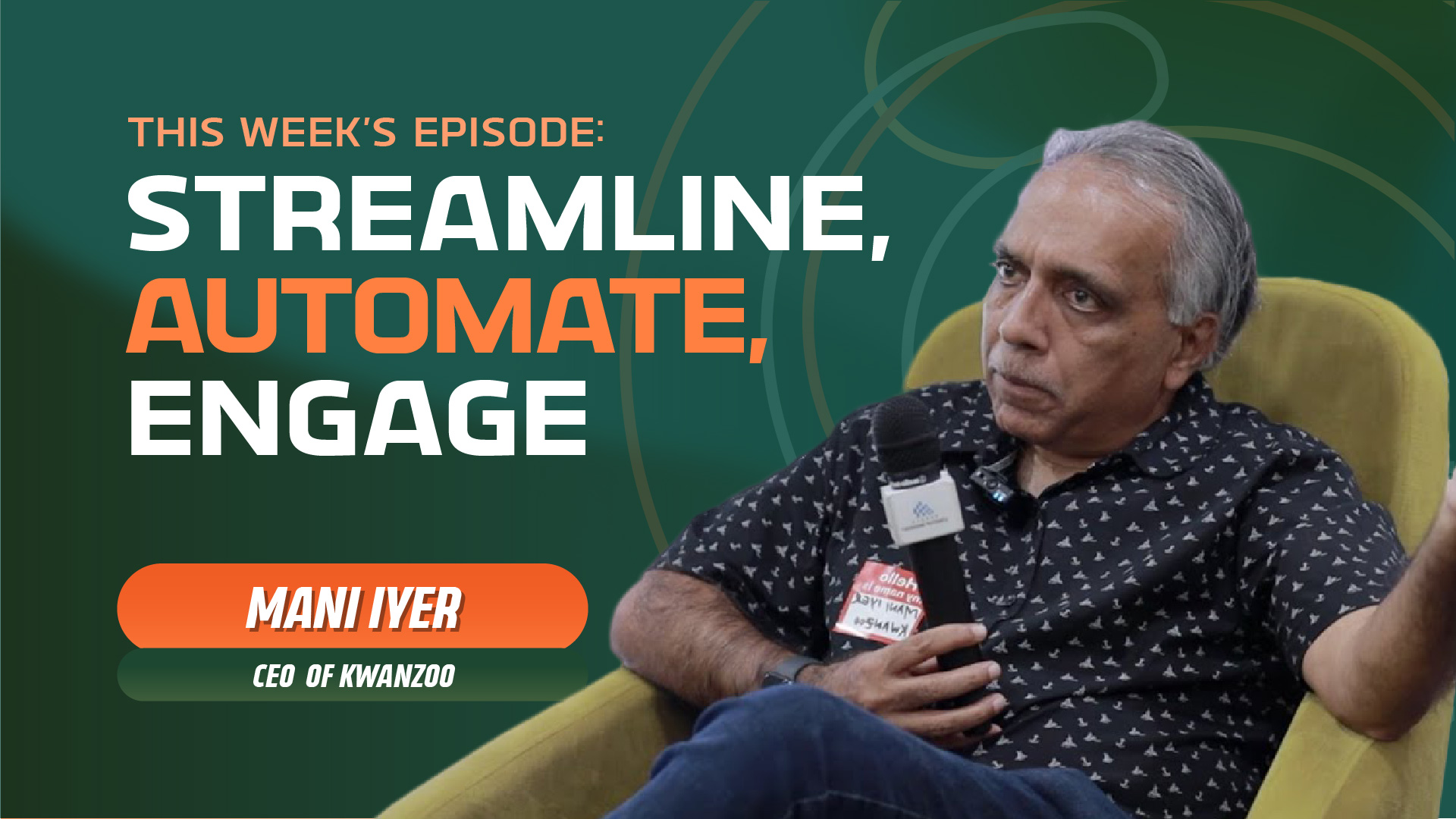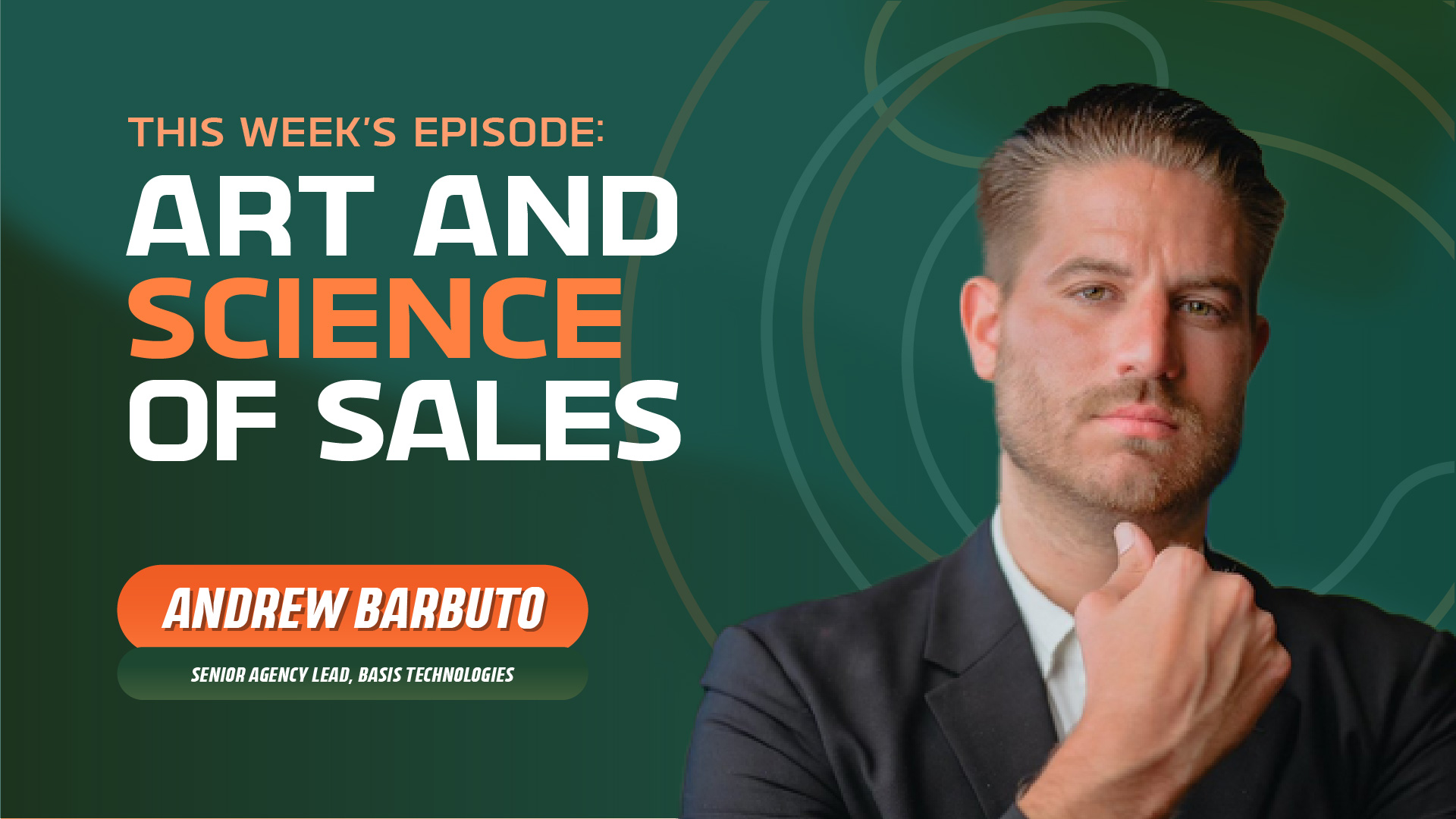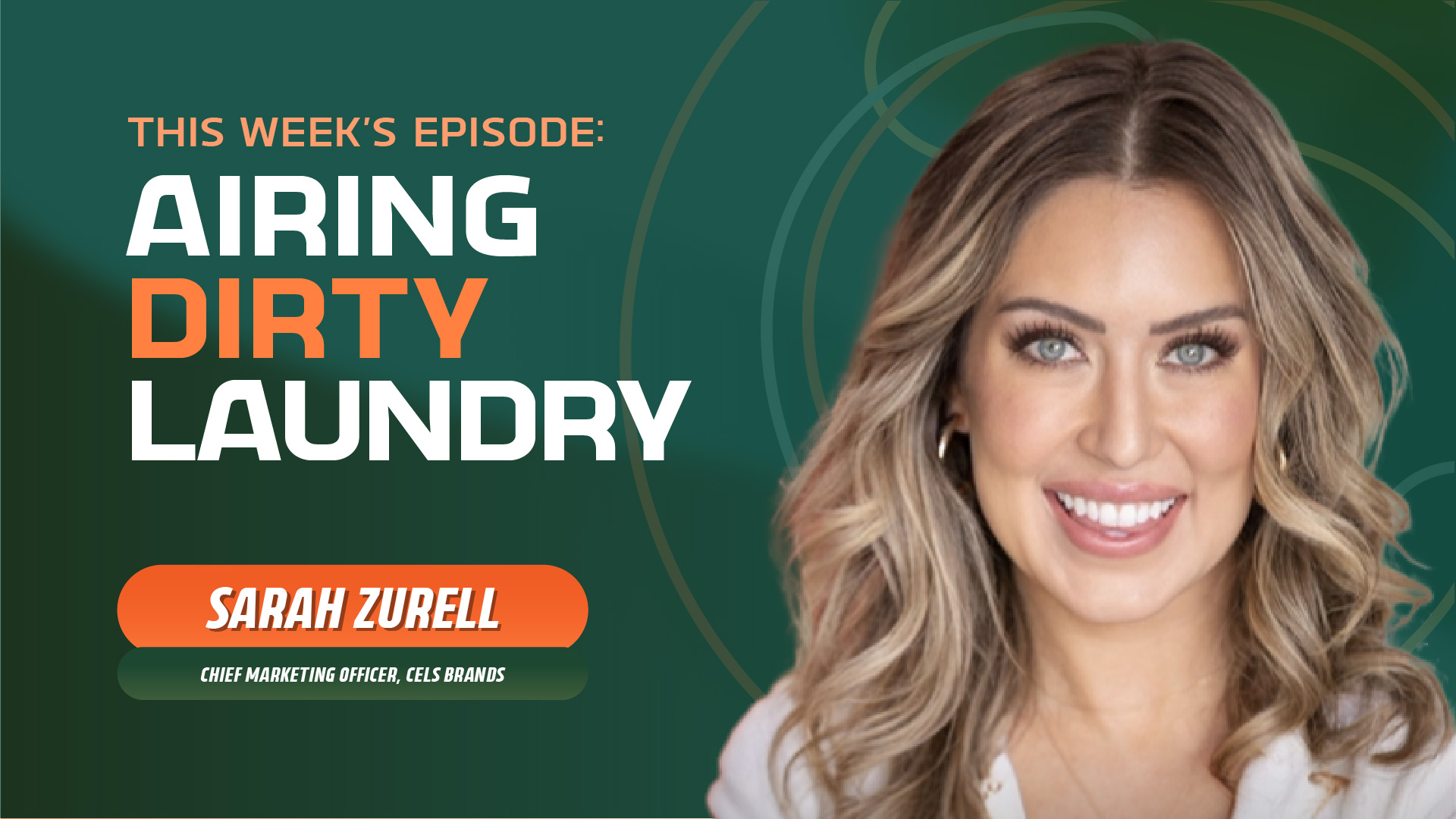Brooke Papiri (Lyft) - Anything and Everything
- 0.5
- 1
- 1.25
- 1.5
- 1.75
- 2
Intro: Maybe big data has gotten too big. Whether you're a B2B marketer or a consumer brand, your data needs to be viable, relevant, and accessible so that Stirista can help you retain customers, acquire customers, and make it personal.
Ben: Welcome to the Marketing Stir podcast by Stirista, probably the most entertaining marketing podcast you're going to put in your ear. I'm Ben, the producer here at Stirista. The goal of this podcast is to chat with industry leaders and get their take on the current challenges of the market, and we'll have a little fun along the way. In today's episode, Ajay and Vincent chat with Brooke Papiri, the chief of staff for marketing and communications at Lyft. She talks about how new services over the years keeps business interesting for customers and employees. Vincent is extra caffeinated and Ajay schedules a haircut. Give it a listen.
Vincent Pietrafesa: Ladies and gentlemen, welcome to another episode of Stirista's The Marketing Stir. I think my voice is back. It was a little hoarse the last episode, probably rooting for too much football. Who knows? Or soccer these days. I'm just basically going to my five- year- old's soccer games. Do I yell? Maybe. Maybe. Should I? Probably not. It's not great to do that and it's probably ruining his self- esteem, but hey, I'm kidding. I don't do that. What kind of a monster would I be? It is so great to be here, ladies and gentlemen. I am extra caffeinated today. Normally I have natural energy, but I'm extra caffeinated. Boy, my two year old's not sleeping. Daylight Savings Time. Remember when Daylight Savings Time used to mean when you didn't have kids I get an extra hour at the bar? Not anymore. It means everyone's sleep is awful, so that is not great. But what is great is this podcast, and our listeners and our cohost and our guests. But let's talk about Stirista for one quick second. That's the only time we talk about Stirista. We are a marketing technology company. We own our own business- to- business data, business- to- consumer data. We help companies access that data through our email sending platform, our DSP. We do email, display, connect to TV, OTT to help you get new customers. Who doesn't need new customers? Email me, vincent @ stirista. com. That is how confident I am. I just gave all of you my email address and you use it, not always for the reason I say, but it's okay, that's on me. I welcome the emails. And ladies and gentlemen, welcome our co- host. You know him, ladies and gentlemen. I will see him in a few weeks. I didn't book my flight yet, that's a mistake. I have to do that, but it'll be great to see him. Ladies and gentlemen, our co- host, the legend in San Antonio there, Mr. Ajay Gupta. What's going on, Ajay?
Ajay Gupta: Hey, Vincent. You'll be excited to hear that I have a haircut planned before your arrival.
Vincent Pietrafesa: Nice. Yes, but I think you're going to get your haircut today or tomorrow. I don't arrive for another month, so I'm not that excited. I want a fresher haircut close to my arrival.
Ajay Gupta: Yeah. My wife would like it longer, my podcast host would like it shorter. It's a tough decision.
Vincent Pietrafesa: I know. For those of you avid listeners to the podcast, or just people who know me and Ajay personally, I am a stickler for haircuts because I go every 10 days. My barber loves me, my photo's on the wall. He thinks I'm this huge celebrity because of this podcast and some other things. He's like, " Vincent, he's big actor." I'm like, " I'm not an actor. What? I sell data," which is my passion, ladies and gentlemen, data. So you're going today and I'll see you in exactly one month. First of all, you need a new barber not of the quality, but I feel like you get four snips and it's like, $ 67.
Ajay Gupta: You could just shave your head off and then you don't have to go back every 10 days. There is that too.
Vincent Pietrafesa: No, because it would get long on the sides. I'm actually going tomorrow. I'll have four haircuts before I see you. True story, I will have four haircuts before I see you. I'm getting a haircut on Wednesday because I'm hosting the Silver Apple Awards for the Marketing Club of New York on November 10th, so you can tell when we record these things. Today's November 8th. Go out there, hopefully you voted. If you didn't vote, don't complain. That's what I tell people. Don't complain if you didn't vote. Anyway, I had voted this morning, took my little son with me. That's when we're doing this. But I still am happy that you're getting a haircut, Ajay, and thank you for thinking of me every time you do it. But excited to be there. We have our virtual summit, which is December 8th. Also, yours truly is hosting that. We have a lot of amazing guests coming up for that, so stay tuned. That's virtual, people could join. That is our third annual. We got a beautiful turnout and we appreciate that. Also, I appreciate this next guest. I'm so happy we have this guest on because I want her perspective. She's at a company called Lyft. Heard of that company? Yes. If you haven't, you live under a rock and you need to get out and travel, you need to get out and do something, so call a Lyft. That's a nice little segue into this. We're so happy we have her, and we're glad to share her with our audience here at Stirista. Ladies and gentlemen, a warm welcome for The Marketing Stir, chief of staff for marketing and communications at Lyft, Brooke Papiri. What's going on, Brooke?
Brooke Papiri: Thank you for that intro.
Vincent Pietrafesa: Of course. See? That's why I do it, to make the guest laugh in the beginning. People are like, " Is he like this all the time?"
Brooke Papiri: All the time. I was going to say, you probably get that question.
Vincent Pietrafesa: I get that a lot. Ajay, am I like this all the time? What would you answer to that?
Ajay Gupta: I think you are actually a little bit toned down on the podcast.
Vincent Pietrafesa: I know. Brooke is like, " Thank goodness I haven't met him yet. A little too much," I know. I'm kidding, I'm kidding. Brooke, it is so great to have you here. We got a lot to talk about. We have a lot to talk about. We're so happy to get Lyft's perspective on just marketing, and today and the last couple years since we've done this podcast, we're on season three now, a lot of great news for you. We'll get into it, but you have a new role, congratulations. We're so happy to hear about that, and we'll get into your old role and now your new role in a little bit. But first of all, we always like to start out every podcast, tell the people out there about Lyft. They should know it you would think, but tell us about Lyft and tell us about your current role, some of your responsibilities, what you've been doing.
Brooke Papiri: Yeah. Absolutely. So Lyft is a ride share company. Ride share, if you are not familiar with it, means that you request a ride through an app on your phone and a Lyft driver will come and pick you up, take you from where you are to your location, a location of you're choosing. We have an option where you can ride of course with a friend or family, and also have options where you can ride with another stranger. That's called our shared product. So ride share has been around for more than a decade, believe it or not, although it still seems kind of new, and really was a disruptor to the taxi industry primarily in terms of offering a new mode of transportation that obviously takes advantage of the technology that we have on smartphones. So that's Lyft. Lyft's broader mission though I should say, you know us for ride share, what I love about the company and this hasn't changed since I got there seven years ago is the mission is really all about creating the world's best transportation, and that's what the mission is. We are very focused on transportation, helping people get from point A to point B a little bit easier, a little bit faster, a little bit more efficiently, and can help also more cost- effectively as well. So most of our offerings that have branched out from beyond ride share are built around transportation. We have partners with transit agencies, bikes and scooters. I can talk a bit more about one of our newest divisions, which is our fleet division, and some of the offerings that we're thinking through there. But that's Lyft in a nutshell.
Vincent Pietrafesa: That's awesome. No, we'll get to that. I love Lyft. You see Lyft, you see the symbol. What's it, almost like a pink? What's that color? It's like a fuchsia pink, it's the logo color. You feel safe when you see it, at least I do. I'm happy it's there when it shows up, L- Y- F- T, right in the window. Oftentimes people have it right in the window. I live in Manhattan, I live in New York City and I don't own a car, so ride share. Lyft comes in handy. It's amazing. I use it. My friends are always shocked, they're like, " You don't have a car?" I'm like, " No, I don't. I have a lot of access to other things," so thank you, Lyft. So Brooke, tell us a little bit about... we always love this question too. We have a lot of people who are just getting into marketing, we have students who listen to this podcast and really thank us for the insights that our guests provide. Talk to us about how you got into marketing in the first place.
Brooke Papiri: Sure. Probably like many of your guests, a bit by accident. I went to school for economics and came out as a consultant. I loved that role, but found that I was looking for an opportunity to do something from a volunteer basis. Got involved with a foundation actually in my hometown of Walnut Creek, which is in the East Bay area, northern California, and I got involved with the Walnut Creek Library Foundation all around building a new library for the city. So as a result of getting involved and I guess the nature of my personality, I started taking on a lot of the marketing work. So I was doing outreach to sponsors, I was setting up the silent auction, I was doing the collateral, just things that I thought of as fun to do. And as I was doing them, I met someone who happened to also be a marketing professional very senior in her career, and she said, " Boy, you sure seem like you have a knack for this and you really enjoy it. Have you ever thought about trying marketing?" So lo and behold, a few months later felt like boy, I was hitting the end of my rope on consulting. She was looking to hire someone at that point, so it was actually a magical transition at the age of 22 to say, " Okay, I'll give this a shot," and turned out I've loved it. So definitely learned how to market on the job. My first job was in healthcare, in marketing, which as it turns out is actually very helpful to work in a very regulated industry as a marketer in your first role because you have to get really good at marketing because you have so many parameters that you have to follow, so I worked in that and that was my first role, and then grew from there.
Ajay Gupta: Brooke, tell us a little bit about Lyft is obviously a pretty well- known brand, but how are you marketing today? Are there specific channels that work particularly well for you?
Brooke Papiri: Gosh, we have done anything and everything. We do digital, social, we've done out- of- home, everything above and below the line you can think of. I will say during COVID particularly, we obviously got even more efficient on our digital channels. A lot of what we stopped doing was anything that we were doing in person, again, out- of- home. Buying billboards was less relevant when no one was leaving their homes. We stopped doing some of our key partnerships and sponsorships and started leaning much more so into digital channels. A lot of what you can imagine with Lyft, it's a two- sided marketplace. So what we're trying to do is reach riders and drivers, both those who have not ridden or driven with us before to bring them onto the platform, but then also those who we want to continue to engage with. So a lot of what we use from an engagement perspective is actually our own channels, so email, social. We use a lot of in- app notifications, really leverage our surfaces within the app itself so that we're communicating with folks when they're riding, when they're considering a ride, and even when they've finished a ride as well, so we have various touch points there. Obviously, contextualizing the experience is always an easier way to communicate with someone, knowing they're already within your app.
Ajay Gupta: And Brooke, you've been there about seven years, which is a rarity these days so that's awesome, and how have you seen the company change and evolve over the years?
Brooke Papiri: We've grown up a fair amount I'd say since I started. We were a few 100 people when I joined seven years ago. We are now several 1, 000, so quite a big leap. I think when you grow 10X let's say, and in some cases even faster at time, inevitably processes have to change, reorgs have to happen. You have to start thinking about how to do things more efficiently at scale more than anything. I think one thing that hasn't changed that I think that keeps me at Lyft is the culture and the people. I always say that Lyft has some of just the brightest and most brilliant folks I've worked with, and they work with a dedication really to the mission and to the brand and to their everyday work, a dedication I haven't seen in other companies, and with very low ego. That breeds a culture that there's a spirit of let's just get it done. We really want to all work together to accomplish the broader goal, and I think it makes everyone work really well as a team regardless of what size we're at.
Vincent Pietrafesa: And Brooke, we mentioned this in the beginning I did about you have a new role. So when we first spoke you were the head of fleet marketing, which you mentioned fleet, and I want to get into that a little bit there because it's not a common title that I've seen before. But now you're the chief of staff for marketing and communications. Congrats by the way, and awesome. And so talk to us a little bit about what the fleet marketing piece was, and then also how you're adjusting to the new role and how your responsibilities have changed.
Brooke Papiri: Sure, yes. In a true Lyft twist, between the time we talked and when we actually did tape this, I have a new role. That has been a bit of the trajectory, I would say, and one of the reasons how you're able to stay somewhere for seven years. I think I've been able to keep it interesting and take on new roles. So I guess starting with what I was doing before, I was the head of fleet marketing. Fleet is one of the lines of businesses within Lyft. Fleet focuses primarily on fleet, meaning fleet of cars, so we think of a fleet like vehicles. So anything to do with cars, both for drivers and for rider. So there can be mechanic services that come to your door or that you can actually be serviced at a Lyft location or a partner location, we offer that actually for riders and for drivers. We also newly offer roadside assistance as a product as well, again, for anyone who's driving a car. It could be our drivers themselves, it could be a rider who also has a personal vehicle. And then we also do rent vehicles both to consumers, again, on the typical what we call rider's side, not an official Lyft driver, but then also to Lyft drivers themselves through a program called Express Drive. So that's a lot of what the fleet business encompasses. It's also very much an incubator for new businesses that are all around personal vehicles, and how do we support who might ride with us? Like you said, Vince, you ride with us because you don't have a car. Some people ride with us and they have a car, but they use us in certain circumstances and then they want to use their own vehicle and other circumstances. And one thing we realized particularly during the pandemic was we have a whole host of services that we've offered to drivers. How can we start to expand those to offer them to just the broader public as well?
Vincent Pietrafesa: And I didn't know about the rental piece, the Lyft rental, That's pretty cool. Has that made its way into every city? Is that in New York City yet?
Brooke Papiri: It's in most markets. I believe we are in New York through partnerships right now, so yes, we do have a partnership with SIXT and with Hertz. Those are our two primary partners, so vehicles are available to rent through the Lyft app often with added benefits, free perks, for example, particularly if you're a pink member, that's our membership program through Lyft. So it's an easy way also to simplify the car rental process. You go to your app and can book it, sometimes same day or well in advance if you want.
Vincent Pietrafesa: Okay. So Brooke, my question around now the marketing and communications, talk to me about as your responsibility now are you helping with marketing to the consumer like me? Is it also to get new drivers? Talk to me about that mix.
Brooke Papiri: Good question. All of the above. My current role right now is really a lot around the operation of the team, how the team's functioning. We had a new marketing leader, or I should say a new leader who was leading in communications at Lyft, Dominic Carr. He took over marketing as well. When he took on marketing, he then asked me to join and be his chief of staff, so move out of the fleet role that I was doing and become chief of staff. But a lot of what we do on a broad basis is think through, like I said, acquiring new drivers, new riders, and then also engaging with those riders and drivers who are already part of our ecosystem, if you will, but encouraging them to ride more and drive more. On the rider's side, it's all about talking about new reasons why someone might want to take a ride. So if you've taken us to the airport, " Hey, did you also know you could take us to run errands? You also could take us actually to the local," in the East Bay it's BART, so sometimes I take a Lyft to BART and then I BART into the city, so we could be that first- last mile connection. So it's really all about introducing new use cases to continue to engage existing users. And then on the driver's side, similar I would say tactics. Obviously a bit different in terms of encouraging a driver to drive with us, it's much more of a means of income for them versus an experience that we're looking to connect on.
Ajay Gupta: Brooke, a lot of people that watch our show are young marketing professionals. What advice do you have for somebody starting out? What are the most important skills you think a marketer needs today?
Brooke Papiri: That's also a good question. One that we focus on quite a bit at Lyft is thinking customer first, and I think that that's so critical, primarily, and again this goes back to what we were saying earlier on how the company's gotten bigger and what has changed, as things get bigger at a company, you have all sorts of different teams who are communicating with rider and drivers. And so it's so critical to remember that in the end, we have to think about the rider's experience with us. It's not about which email goes in out on Tuesday, which one goes on Wednesday, which one goes on Thursday, it's actually much more about but wait, if I'm a rider and I've gotten all these different messages about different products or different services that Lyft offers, what is that telling me about the company? What is it telling me also about how am I feeling about getting this many emails? I think there's a lot to take into account on a broader basis, so remembering big picture in terms of what the customer experience is, and also thinking about the customer from the perspective of not so much why did we build this product or how did this product come to life internally, but what could this product do for a customer that we want them to really understand in terms of solving a problem in their day- to- day? So I think that's one I always think of, thinking customer first. It's one of the first things I ask anyone on my team if they bring me a brief. That's one piece that we really emphasize, again, both on my team and then I would say more broadly at Lyft. Other skills, I would say you have to have a genuine curiosity about people. I think you really have to think through what makes someone make a decision? What is it that you think you can say that will encourage someone to consider your product or your brand or your service? And you have to be able to be... what do I want to say... take yourself out of the situation and have a genuine curiosity about how other people think as well. So who is your target market? Frankly, who isn't your target market and why aren't they your target market? I think understanding those pieces and being curious about what is it that makes people the way they are and decide the things they do would be the other piece. And then it again goes back to Lyft I would say just being adaptable. Again, as I've mentioned, I've had many different roles at Lyft. I think one of the biggest pieces of advice I give to anyone is when you see a change, look at it as an opportunity and think through how you can adapt your current skillset to that maybe fit a need. Similarly, I would say when it comes to marketing, I think marketers are famous for planning campaigns for 12 weeks and then you get to launch it and the day of something in the universe explodes and your campaign is completely irrelevant, so how do you also adapt in those kinds of moments? So bigger picture adaptability, but then also literally in the moment, thinking through how to be adaptable from a pure work perspective.
Ajay Gupta: And Brooke, how do you see Lyft in terms of how it competes with its competitors? It's obviously a very competitive space when it comes to ride share.
Brooke Papiri: We have one primary competitor. Most folks know them by name, so I won't name them here. But I will say we have very different strategies, and over the years it's become very clear. We are focused on transportation and we transport people. We want to create the world's best transportation, that's why we focus on growing our network of transportation options. So again, like I mentioned, all of the work we're doing in fleet, really nascent businesses around your personal car and how that can be an option. Bikes and scooters as an option, partnerships with transit as an option, rental cars, as we mentioned, is another option. So all around though, how do we help you, the consumer, the person, get around your city more easily? Our competitors do also still do ride share. They do some of the businesses I mentioned as well, but they've also branched out into thinking through moving things, food for example, or freight in a different way. And because of that, I would say our strategies and how we think, who connect to more than anything is different, and you also will see that in the brand itself. Lyft is very much a brand that connects the consumer. We talk to you the same way we talk to a friend, and that's really what we think through our brand is one that people can relate to as is our service, so I think that's where we try to stand apart.
Vincent Pietrafesa: That's awesome. We don't talk about competitors here. We don't name any other competitors, I love it. So Brooke, talk to us about some of the changes that you've made or implemented at Lyft that you're really proud of during your career there.
Brooke Papiri: Gosh, changes. Well, I am a big process person, so I've probably instituted all sorts of processes. Part of the reason why this chief of staff role is actually one that's working out very well, as it turns out, my mind works in a fashion of operating to the greatest efficiency while also very much understanding the nuances of marketing. So a lot of that, from a pure what I was doing when I started and what Lyft looked like until now, a lot of my role at the start was around launching new cities. When I joined Lyft, believe it or not, we were not in every US city, not even every major US city, so a lot of the change that I was part of was actually launching new markets. So I would go into a market and we would launch the city, we would onboard drivers in person. Imagine that, if you can. We would show up at the local grocery stores and anywhere we could to find people to talk to them about what Lyft is and why they might want to try to ride with us. So a lot of really grassroots efforts I would say around building the brand and really building the entire Lyft network. Now we're obviously all over the US up into Canada, so it's been really fun to be a part of very much a physical expansion, and then also just the growth of the brand and the company. As you said, " If you don't know Lyft, I don't know where you've been," years ago, I definitely would have to explain what Lyft is to folks.
Vincent Pietrafesa: No, nice. You don't think about it, you just assume it's in every city. What do you mean? But no, it has to get there. I love the grassroots approach. That's amazing, just going out there, talking to people. I miss that. I miss that. It's coming back. It's coming back, ladies and gentlemen, so that is great. So Brooke, I know you are a big supporter, advocate of female leadership, and I want to talk to you about are there any experiences you believe are unique to women in this field, and how do you advocate for female leadership?
Brooke Papiri: I'm obviously a huge advocate of female leadership. I think more than anything, I always say the mindset I've tried to use is that if I see an opportunity, I don't think about whether it's an opportunity for a woman or a man or me or someone else, I think if it's an opportunity that excites me, I'm going to go after it. And so I think often I will really encourage women to think less about can I be a woman leader, a female leader? Can I be a woman in power? And think more about what is the leader you want to be and what type of roles get you excited? And I think if you focus more on what it is you want to do and what you want, who the leader you want to be, you actually worry less about gender and it will naturally fall into place. I will say, marketing obviously is a field also where there you do tend to find more females in this field more so maybe than others, so it may also be that I've just been fortunate that I've grown up with a community of marketers where I've always seen female leadership, so I just never really questioned it. I think that's the approach I recommend, is not to get too hung up on it and think more about the opportunity itself.
Ajay Gupta: Somewhat related to it, can you talk a little bit about Lyft's effort for social responsibilities?
Brooke Papiri: Yeah. Actually, it's a great day for that, as it turns out. We do have a voting access program. So I will say it's going to be a bit late now, but we actually have a code out. If you want to go to the polls, you can get 50% off a ride on Election Day. We've done this for years now, it's really well- received really. We see a high take rate also as well on these rides, so we're excited that people really do take advantage of them. But that's part of our Lyft UP program. So Lyft Up is a program all around access. How do we give access to groups, communities who may need access to rides? And that can be during a specific situation, a terrible crisis that happens unfortunately far too often these days, a weather situation where someone needs to get out of somewhere quickly, whether it's an evacuation notice or something else. And then also for specific cases like today, getting out to vote. We want to make sure that you get out there, that your voice is heard. And then also, another great program we run is our jobs access program where we actually help you get to and from interviews. So we will help you go to and from an interview, we'll even help you in the first few weeks of your job go back and forth to your job as well, so you make sure you get off to a great start, and we work with awesome partners who help us also facilitate getting these rides and ride codes into the right hands of people who need them the most.
Ajay Gupta: Oh, I did not know that about the interviews. That's pretty cool.
Brooke Papiri: Yeah. It's pretty cool, right?
Ajay Gupta: Speaking of elections, obviously gas prices is a hot button topic. How has that affected Lyft's price model?
Brooke Papiri: Good question. Definitely been an issue. I know anyone who drives their own car feels it probably lesser than our Lyft drivers, but our Lyft drivers really feel it. We have added a surcharge onto every ride. For any rider who takes a ride is going to pay a little bit more, that's going to go directly to the driver to help offset their cost of gas. It's not perfect, but it's something at least that we want to be a partner to our drivers in that. And the other opportunities that we offer, we have a partnership with Upside. Upside actually offers discounts on gas to our drivers, and we also have other programs as well for our tiered drivers. So those are drivers who drive with us usually full time or longtime drivers where we offer, again, specific discounts on products to help them care for their cars, including things like gas discounts as well.
Vincent Pietrafesa: Brooke, just as we begin to wrap up here, we have a couple more questions for you. One of them is our signature question that we ask all of our guests. I feel like James Lipton. Remember the James Lipton guy?
Brooke Papiri: Oh, so good.
Vincent Pietrafesa: We ask all of our guests this question. So LinkedIn platform, your title, a lot of people probably reach out to you requesting messaging. What is a LinkedIn message that you dislike and what is one that you're receptive to?
Brooke Papiri: That's a good question. I do get a lot of LinkedIn messages, I will say that. I guess what I'd say first, the request to connect on LinkedIn, always send a note. I'm amazed at people who just blindly will send me a request. Even if we have someone in common, just send me a note to say that, " Hey, I wanted to connect with you because I know so and so and she thought it would be good if we connect," great. If I don't know you and you want to connect, just tell me why. I think that's so simple, right? I read them, I do, because I'm not that big a deal. I still read them all.
Vincent Pietrafesa: I like that.
Brooke Papiri: But the ones you want to connect with are the ones who take the time to write a note, and even more so, take the time to write a thoughtful note as to why they'd like to connect. And same goes with messages. I don't know. I think, what should I say, I have a real aversion to the drip campaigns that appear to be happening in LinkedIn, where I will actually respond and say, " I'm not the right person to connect with you, but I can connect you to someone else," and then four hours later I get another note from the same person that says they're bummed they haven't heard from me. So I think those start to feel tacky, so I guess I would always say to someone if you're going to be really heavily tech on your drip campaigns, be sure you check your inbox also so that you don't have a funny extra note go out that doesn't make any sense at that point.
Vincent Pietrafesa: Yeah. No, I agree. I always get burned by those, the connections, and I look. I think the rule of thumb is if I have 50 connections in common and you don't send me a note, I will still connect. But as soon as you hit me with that first message seconds later, that's it, I've learned how to remove the connection.
Brooke Papiri: Yes.
Vincent Pietrafesa: I take my network very seriously, and after 125 episodes plus, people know my opinion on that because we ask every single guest this. But I like that. Just include a note. And you're really nice, Brooke, because you're saying, " I will also connect you with the person who is responsible." You're nice, but don't take this as an opportunity to reach out to Brooke for those. Anyway, so Brooke, let's talk about that. That's obviously a social media platform, if you will, for business professionals. The marketing story that people want to know, are there platforms or social channels that you've had success with for Lyft? What do you think the best means of communication is out there?
Brooke Papiri: We have an awesome social team, one team that I interact with more so on an admiration basis I would say more than anything, but they do a great job across channels. I will say probably many marketers, TikTok is definitely the one that's up- and- coming. From a Lyft brand perspective, again, we don't take ourselves that seriously. We like to have a good time. We like people to think of us, yes, for ride share, for transportation, but the same time, we also like you to think of us as a fun brand. Again, we talk to you like a friend and most of the time we're having a good time, so TikTok has lent itself well I would say to I don't want to say irreverent, but funny scenarios that we can bring to life on a channel where people are really engaged with content and ready to laugh. And so often I think it's how do you make content that's super relatable also very funny? For Halloween we did a bunch of content around getting in and out of Lyft cars with costumes on, mainly because it's funny because you watch a bunch of people with crazy costumes getting in and out of cars. It's just entertaining, but also because it's relatable. You've done that before. You've been in a costume and you've had to get in and out of a car, and it's funny because you're like, "God, I remember that same feeling. I don't know how to get my jacket or purse as well as my large dinosaur looking ensemble out of a car." So TikTok is a lot of fun.
Vincent Pietrafesa: That is, and that's a surprising one too. A lot of people are like, " I haven't embraced that yet." We were surprised to hear that in a few other brands. Lyft is a brand that's just come on, like you said, the last 10 years, but we've talked to some brands that have been around for 100 years that are like, " We use TikTok." We're like, " Really? Wow. Okay." But it seems to work for them. So Brooke, tell us about yourself personally. You and I were joking before, you're a Northern Californian through and through.
Brooke Papiri: Through and through.
Vincent Pietrafesa: What do you like to do in your spare time besides enjoy the amazing weather and the sunlight and just the wineries I would imagine are up there too and all that good stuff? But tell us about yourself personally. What do you like to do?
Brooke Papiri: Yeah, thanks for asking. Yes, born and raised in California, Northern California. Stayed here for all schooling as well, as ridiculous as that is. I have a rainy day behind me now, but definitely enjoy the sunshine. We have a golden retriever so we do spend a lot of time outdoors, and I have a 15- month- old son who keeps me very busy.
Vincent Pietrafesa: Oh, yep.
Brooke Papiri: Yes. 15 months, so is walking, almost running at this point, talking, getting into everything he can, so that is most of my nights, mornings and weekends.
Vincent Pietrafesa: Yeah, I know. Early mornings. Those early mornings. But like I said, the Daylight Savings Time, so I'm sure you could relate to that. I know. I have a two- and- a- half- year- old and a five- year- old. That's awesome. Well, congratulations on the little guy there. And Brooke, this has been amazing. We really enjoyed having you and talking to you and giving your perspective. Check out Lyft, ladies and gentlemen. If you don't have it, go out, download it on your phone. Don't bombard Brooke with messages please, even though she's very nice. But this has been amazing, Brooke. Congrats on the new title and position, you're doing some great things there. That is Brooke Papiri, the chief of staff of marketing and communications at Lyft. I'm Vincent Pietrafesa, that's Ajay Gupta. This has been another episode of Stirista's The Marketing Stir, thank you so much for listening and we'll talk to you soon.
Ben: Thanks for listening to the Marketing Stir podcast by Stirista. Please like, rate and subscribe. If you're interested in being a guest on the podcast, please email us at themarketingstir@ stirista. com, and thanks for listening.
DESCRIPTION
Ajay and Vincent chat with Brooke Papiri, the Chief of Staff for Marketing and Communications at Lyft. She talks about how new services over the years keeps business interesting for customers and employees. Vincent is extra caffeinated, and Ajay schedules a haircut.
Today's Host
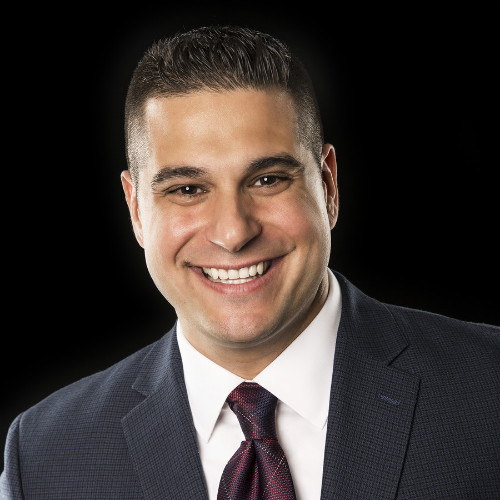
Vincent Pietrafesa

Ajay Gupta
Today's Guests

